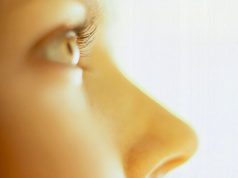Technique allows for precise estimation of the long-term outcome of rotation of the nasal tip
TUESDAY, Feb. 27, 2018 (HealthDay News) — The new domes technique appears to be reliable in most patients undergoing primary rhinoplasty, according to a study published online Feb. 22 in JAMA Facial Plastic Surgery.
Fernando Pedroza, M.D., from La Font Clinic in Bogota, Colombia, and colleagues retrospectively reviewed outcomes for 323 patients undergoing primary rhinoplasty with the new domes technique performed by a single surgeon from Jan. 1, 2011, through Jan. 31, 2016, in a private clinic in Colombia. Measurement of the rotation angle of the nasal tip before surgery and one week and six months after surgery was assessed.
The researchers found that the mean preoperative nasolabial angle was 92.7 degrees. At one postoperative week it was 105.5 degrees, and at six months after surgery it was 102.1 degrees. Per lateralized millimeter, the mean increase of the rotation achieved was 3.6 degrees, but the mean rotation angle at six months decreased to 3.4 degrees.
“Despite the unpredictable inflammatory changes, the exact lateralization in millimeters with the new domes technique allowed precise estimation of the long-term outcome of the rotation of the nasal tip, enabling the surgeon to determine from the preoperative plan the definitive rotation angle of the nose,” the authors write.
Copyright © 2018 HealthDay. All rights reserved.








